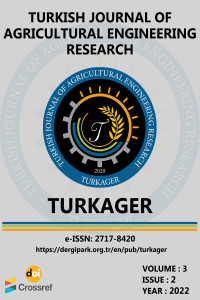Öz
Anahtar Kelimeler
Rice mill Pre-cleaning residues Purifying Special feeder Small birds
Destekleyen Kurum
Agricultural Engineering Research Institute (AENRI).Dokki- Giza - Agricultural Research Center (ARC), Ministry of Agricultural, , Egypt,
Kaynakça
- Anikwe MAN (2000). Amelioration of a heavy clay loam soil with rice husk dust and its effects on soil physical properties and maize yield. Bioresources Technology, 74: 169-173. https://doi.org/10.1016/S0960-8524(00)00007-9.
- Barkworth ME, Capels KM, Long S and Piep MB (2003). Flora of North America, 25. http://herbarium.usu.edu/webmanual/ (2012).
- Ebling PD, Kessler AM, Villanueva AP, Pontalti GC, Farina G and Ribeiro AML (2015). Rice and soy protein isolate in pre-starter dites for boilers. Poultry Science, 94 : 2744-2752. https://doi.org/10.3382/ps/pev279.
- EL-Shabrawy TH and Al-Rajhi MA. (2020). A simple device for barnyard seeds purification to use it as feeder for small birds. Journal of Soil Sciences and Agricultural Engineering, Mansoura University, 11(6): 157-161.
- Emami S, Tabil LG, Tyler RT and Crerar WJ (2007). Starch protein separation from chickpea flour using a hydrocyclone. Journal of Food Engineering 82(4): 460-465. https://doi.org/10.1016/j.jfoodeng.2007.03.002.
- FAOSTAT (2017). Food and Agriculture Organization of the United Nations: Preliminary Agricultural Production data. http://www.fao.org/economic/est/publications/rice-publications/rice-market-monitor-rmm/en/.
- Heap I (2014a). Global perspective of herbicide-resistant weeds. Pest Management Science, 70: 1306-1315. https://doi.org/10.1002/ps.3696.
- Kramer GW, Euliss NH,Jr. (1986). Winter foods of black-bellied whistling-ducks in northwestern Mexico. Journal of-Wildlife-Management 50 (3):413-416.
- Mitich LW (1990). Intriguing world of weeds. Barnyardgrass. Weed Technology, 4(4): 918-920. https://doi.org/10.1017/S0890037X00026671.
- Njoku C, Mbah CN and Okonkwo CI. (2011). Effect of rice mill wastes application on selected soil physical properties and maize yield (Zea mays L.) on an ultisol in Abakaliki, Southeastern Nigeria. Journal of Soil Science Environmental Management, 2(11): 375-383. https://doi.org/10.5897/JSSEM.9000028.
- Njoku C, Mbah CN (2012). Effect of burnt and unburnt rice husk dust on maize yield and soil physic-chemical properties of an ultisol in Nigeria. Biological Agricultural and Horticulture, 1: 1-12. https://doi.org/10.1080/01448765.2012.664374.
- Oida A (1997). Using personal computer for agricultural machinery management. Kyoto University. Japan. JICA Publishing.
- RRTC (2018). Rice research and training center (National Rice Research Program): Final results of 2012- 2017 growing season. Sakha, Kafrelsheikh, Egypt.
- Rubinelli PM, Kim SA, Park SH, Roto SM, Nealon NJ and Ryan EP, Ricke SC (2017). Differential effects of rice bran cultivars to limit Salmonella Typhimurium in chicken cecal in vitro incubations and impact on the cecal microbiome and metabolome. PLOS ONE 12: e0185002. https://doi.org/10.1371/journal.pone.0185002.
Öz
Kaynakça
- Anikwe MAN (2000). Amelioration of a heavy clay loam soil with rice husk dust and its effects on soil physical properties and maize yield. Bioresources Technology, 74: 169-173. https://doi.org/10.1016/S0960-8524(00)00007-9.
- Barkworth ME, Capels KM, Long S and Piep MB (2003). Flora of North America, 25. http://herbarium.usu.edu/webmanual/ (2012).
- Ebling PD, Kessler AM, Villanueva AP, Pontalti GC, Farina G and Ribeiro AML (2015). Rice and soy protein isolate in pre-starter dites for boilers. Poultry Science, 94 : 2744-2752. https://doi.org/10.3382/ps/pev279.
- EL-Shabrawy TH and Al-Rajhi MA. (2020). A simple device for barnyard seeds purification to use it as feeder for small birds. Journal of Soil Sciences and Agricultural Engineering, Mansoura University, 11(6): 157-161.
- Emami S, Tabil LG, Tyler RT and Crerar WJ (2007). Starch protein separation from chickpea flour using a hydrocyclone. Journal of Food Engineering 82(4): 460-465. https://doi.org/10.1016/j.jfoodeng.2007.03.002.
- FAOSTAT (2017). Food and Agriculture Organization of the United Nations: Preliminary Agricultural Production data. http://www.fao.org/economic/est/publications/rice-publications/rice-market-monitor-rmm/en/.
- Heap I (2014a). Global perspective of herbicide-resistant weeds. Pest Management Science, 70: 1306-1315. https://doi.org/10.1002/ps.3696.
- Kramer GW, Euliss NH,Jr. (1986). Winter foods of black-bellied whistling-ducks in northwestern Mexico. Journal of-Wildlife-Management 50 (3):413-416.
- Mitich LW (1990). Intriguing world of weeds. Barnyardgrass. Weed Technology, 4(4): 918-920. https://doi.org/10.1017/S0890037X00026671.
- Njoku C, Mbah CN and Okonkwo CI. (2011). Effect of rice mill wastes application on selected soil physical properties and maize yield (Zea mays L.) on an ultisol in Abakaliki, Southeastern Nigeria. Journal of Soil Science Environmental Management, 2(11): 375-383. https://doi.org/10.5897/JSSEM.9000028.
- Njoku C, Mbah CN (2012). Effect of burnt and unburnt rice husk dust on maize yield and soil physic-chemical properties of an ultisol in Nigeria. Biological Agricultural and Horticulture, 1: 1-12. https://doi.org/10.1080/01448765.2012.664374.
- Oida A (1997). Using personal computer for agricultural machinery management. Kyoto University. Japan. JICA Publishing.
- RRTC (2018). Rice research and training center (National Rice Research Program): Final results of 2012- 2017 growing season. Sakha, Kafrelsheikh, Egypt.
- Rubinelli PM, Kim SA, Park SH, Roto SM, Nealon NJ and Ryan EP, Ricke SC (2017). Differential effects of rice bran cultivars to limit Salmonella Typhimurium in chicken cecal in vitro incubations and impact on the cecal microbiome and metabolome. PLOS ONE 12: e0185002. https://doi.org/10.1371/journal.pone.0185002.
Ayrıntılar
| Birincil Dil | İngilizce |
|---|---|
| Konular | Ziraat Mühendisliği |
| Bölüm | Araştırma Makaleleri |
| Yazarlar | |
| Erken Görünüm Tarihi | 16 Aralık 2022 |
| Yayımlanma Tarihi | 31 Aralık 2022 |
| Gönderilme Tarihi | 19 Mayıs 2022 |
| Kabul Tarihi | 18 Temmuz 2022 |
| Yayımlandığı Sayı | Yıl 2022 Cilt: 3 Sayı: 2 |
Uluslararası Hakemli Dergi


